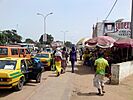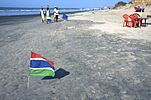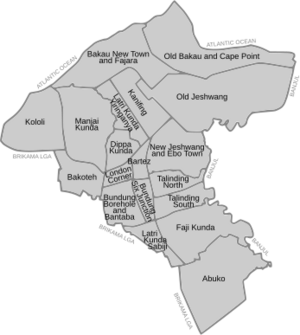Kanifing facts for kids
Quick facts for kids
Kanifing
|
||
|---|---|---|
|
Urban municipality
|
||
|
|
||
|
||

Location of the Kanifing Local Government Area in the Gambia
|
||
| Country | The Gambia | |
| Local government area | Kanifing | |
| District | Kanifing | |
| Government | ||
| • Type | Mayor–council government | |
| • Body | Kanifing Municipal Council | |
| Area | ||
| • Land | 75.5 km2 (29.2 sq mi) | |
| Population
(2013)
|
||
| • Total | 382,096 | |
| • Estimate
(2023)
|
391,270 | |
| Website | http://kanifing.gm/ | |
Kanifing is a municipality, local government area and district in the Gambia. It is part of the Greater Banjul Area, to the west of Banjul. It is governed by the Kanifing Municipal Council.
Kanifing is one of the country's most densely populated places and its most populated district. Its population expanded in the post-colonial era. It has received many migrants from the rest of the Gambia and abroad. It has large populations of many ethnicities.
Kanifing is the economic center of the Gambia. Serekunda is the country's largest population center. Tourism is a major industry. There are several higher education institutes, including the University of the Gambia.
Contents
History
Sayerr Jobe founded Serekunda, the first settlement in the forested area, in the nineteenth century. He helped establish other settlements in Kanifing, including Bundung and Ebo Town.
In 1840, France ceded a 40-square-kilometer area called British Kombo, later renamed Kombo St. Mary. It annexed another French cession in 1853. It was part of the Gambia Colony. The Protectorate Ordinances, passed between 1894 and 1902, transferred it to the administration of the Gambia Protectorate. It returned to the Colony in 1946. The local government area (LGA) of Kombo St. Mary was created in the 1960s from part of the Brikama LGA. It was the eighth LGA to be established. The Kombo Rural Authority was renamed the Kanifing Urban District Council in 1974 and the Kanifing Municipal Council in 1991.
Kanifing grew significantly in the post-colonial era. This was largely caused by immigration from nearby countries; in 1993, foreign nationals made up 20% of the population of the LGA. Kanifing's growth led to the country's urbanisation rate to increase from 23% in 1973 to 37% in 1993. This expansion led to higher property values and foreign investment.
Geography
Kanifing is one of the eight local government areas of the Gambia. It is the only one that contains only one district.
Kanifing has a land area of 75.5 square kilometers. It lies immediately west of the capital city Banjul, with this joint conurbation known as the Greater Banjul Area. Serekunda, the country's largest urban area, is in Kanifing.
Demographics
| Historical population | ||
|---|---|---|
| Year | Pop. | ±% |
| 1963 | 12,208 | — |
| 1973 | 39,404 | +222.8% |
| 1983 | 101,504 | +157.6% |
| 1993 | 228,214 | +124.8% |
| 2013 | 377,134 | +65.3% |
Kanifing Municipality has a population of 377,134, as of the 2013 census. This makes it the country's most populated district, as well as the most densely populated.
The 2023 population estimate is 391,270. The sex ratio is 1:1. The mean household size is 6.7. There are 40,367 people (11.63% of the population) in poverty, 3,340 (1.0%) in extreme poverty, and 117,648 (33.9%) in food poverty.
The predominantly rural Mandinka people moved to cities in the post-colonial era. Kanifing's share of the Gambia's Mandinka population increased from 3% in 1963 to 16% in 1993. In 1993, Kanifing had about one-third of the country's Jola people, about one-quarter of Serahuli people, nearly one-third of Serer people, and the majority of Aku people. It had nearly half of the country's Christians.
The population has grown through both internal migration and immigration, being home in 2013 to 30% of the country's immigrants and 35% of the country's internal migrants. The total number of immigrants was 33,790, of which 34% were from Senegal and 25% were from Guinea.
In Kanifing and Banjul, the Wolof language is spoken as a lingua franca in multi-ethnic groups, rather than Mandinka as in the rest of the country.
Settlements
Kanifing has nineteen settlements:
| Settlement | Population | ||
|---|---|---|---|
| 2013 | 2003 | 1993 | |
| Abuko | 15811 | 8958 | 4345 |
| Bakau New Town | 25265 | 31600 | 26687 |
| Bakau Wasulun | 3545 | 1312 | 2195 |
| Bakoteh | 16924 | 17161 | 6594 |
| Bundungka Kunda | 55360 | 51869 | 41369 |
| Dippa Kunda | 17654 | 14965 | 15081 |
| Ebo Town | 22789 | 18363 | 2563 |
| Faji Kunda | 38121 | 23969 | 12744 |
| Kololi | 7257 | 5498 | 4416 |
| Kotu | 16358 | 11844 | 4419 |
| Kanifing | 14296 | N/A | N/A |
| Pipeline | 4317 | N/A | N/A |
| Latri Kunda German | 19765 | 24045 | 22902 |
| Latri Kunda Sabiji | 15619 | 14939 | 11289 |
| Manjai Kunda | 18601 | 14372 | 4800 |
| New Jeshwang | 17394 | 17023 | 21656 |
| Old Jeshwang | 7552 | 13319 | 8480 |
| Serekunda | 19944 | 19292 | 18901 |
| Talinding | 40562 | 34206 | 19773 |
Administration
Administrative divisions
The Kanifing Municipal Council (KMC) is led by the Lord Mayor of Kanifing, who has administrative duties. Ward councilors manage social and economic duties. KMC is divided into eighteen wards: Abuko, Bakau New Town, Bakoteh, Bantaba Bore Hole, Bartez, Bundung Six Junction, Dippa Kunda, Fajikunda, Kanifing, Kololi, Latrikunda Sabiji, London Corner, Manjai Kotu, New Jeshwang/Ebo Town, Old Bakau/Cape Point, Old Jeshwang, Tallinding North, and Tallinding South. It is further divided into seventy-four sub-wards, each led by a sub-ward chairman.
The municipality has seven parliamentary constituencies: Serekunda East, Serekunda West, Serekunda Central, Jeshwang, Bakau, Latrikunda Sabiji, and Tallinding.
Economy
Kanifing is the main commercial area of the Gambia, and is the district with the highest concentration of industry, hosting a large industrial estate. Most of the Gambia's hotels and coastal resorts lie within the municipality, as does the national football stadium. While government administration is an important component of the economy, 50.8% of the workforce is employed in the private sector. Altogether, 32.5% of workers are in wholesale and retail trade, 13% in manufacturing, and 17.5% in services.
Of the 251,712 people who are 15 or older, 122,726 are in the labor force, including 108,474 who are employed and 14,252 who are unemployed. The unemployment rate among workers aged 15 to 35 is relatively low for the country, at just 6.5%, although within this age range over 20% of those with higher education are unemployed. Child labor affects 3.5% of children aged 5–11, 9.7% aged 12–14, and 14.6% aged 15–17.
Bensouda's government has planned an affordable housing project to build 8,000 homes.
Infrastructure
Waste management
The Local Government Act (the Gambia) 2002 gives municipalities the responsibility of waste management. The Environment and Sanitation Unit (ESU), part of KMC's Directorate of Services, is responsible for waste and other environmental health issues. The ESU performs daily street cleaning and market waste collection, collects waste from public facilities, and clears illegal dumps. KMC has no official waste separation or recycling programmes. KMC spends 25% of its budget on waste management.
The Bakoteh Dumpsite is the largest in the country, collecting all waste in the Greater Banjul Area. It was created as part of a defunct mining operation. It is overfilled and does not have modern disposal systems. It is located in a dense area, near Bakoteh, Dippa Kunda, and Manjai Kunda. Its environmental impacts include methane fires, water contamination, and odour. The city hires bulldozers to transport waste to the dump, but it is sometimes blocked from being waterlogged in the rainy season. Many residents of the area around the dumpsite make a living from informal recycling. KMC has planned to establish a new dumpsite and turn the old one into a transfer station. In 2021, it performed a pilot program to compost the organic waste in the dump and convert it to biofuel.
The Mbalit project (meaning waste in Wolof) performs household waste collection. It assigns each ward a garbage truck that collects waste from each household weekly. It uses a digital ticket system to pay for the service. Informal waste collectors use donkey-drawn carts to collect waste from households not covered.
In 2022, KMC estimated that it had 460 tons of waste per day, of which 57.5% is from households, though this data is imprecise. The city has 370 waste management workers, of which 227 are under the ESU and 143 are under the Mbalit project, As of 2022[update].
Bensouda called waste management his number-one priority as mayor. KMC developed a five-year waste management plan (2017 to 2021) in consultation with the community and the private sector. It focused on public awareness, new waste sorting strategies, expanded household waste collection, job creation, and partnerships with informal waste management. It created the Mbalit project, the first household waste collection programme in the Gambia. With a grant by the European Union, Bensouda launched the Kanifing Environmental Transformation Programme (KETP), which donated waste collection equipment for the initiative. It set up ten communal skip bins and reduced the number of illegal dumpsites from 65 to 17. The programme's success improved the government's image.
Transport
The Gambia Transport Service Company has a bus depot in Kanifing. It runs international buses to Dakar and Bissau.
Bensouda's government has planned an urban bus system with fifty buses and twenty routes.
Education
Kanifing has most of the country's tertiary education institutes, including the University of The Gambia, the American International University West Africa, the Gambia Technical Training Institute, and the Management Development Institute.
Kanifing's library began construction on 18 August 2022. It will be the first municipal library in the country. It is an initiative of Bensouda and the KETP, with funding from te Peterborough City Council in England. The project cost 45 million dalasi.
Sport
The Kanifing Municipal Sports Committee (KM Sport) is one of the Gambia's seven regional sports organisations. Its chairperson, elected from the chairpeople of its constituent district sport committees, represents Kanifing in the National Sports Council.
Sister cities
Kanifing is twinned with:
 Madison, Wisconsin, United States
Madison, Wisconsin, United States Mbao, Senegal
Mbao, Senegal
Madison has provided funding for Kanifing's garbage trucks and its public library.
External websites
- Government of Kanifing








